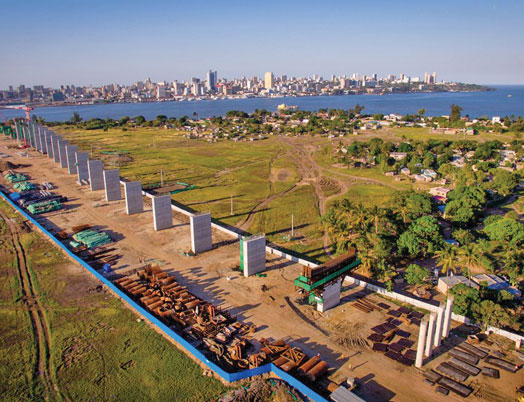Mozambique government and partners invest more than US$170 million in road reconstruction
Maputo-Katembe Bridge: A project that inspires – Notícias

Notícias
The project came at an initial estimated cost of US$1,040 million and is being executed by the China Road and Bridge Corporation. Each passing day, signs of progress sharpen the expectations of future users, and not only because the bridge will can improve the movement of people and goods from the capital to the southern part of Maputo province.
The bridge will also connect the central Maputo with the municipal Katembe district, and will therefore have a regional dimension, connecting with South Africa via Goba and Ponta do Ouro along a route that currently comprises a dirt road and a ferry.
The bridge will be one of the largest in Africa, with towers 135 metres high and with a length of about three kilometres. The central suspended span is 680 meters and is 60 meters above sea level to allow for maritime traffic.
As a development, it will undoubtedly will lend the capital a more attractive and inspiring air.
For its implementation, the CBRC construction company had by March mobilized more than three thousand employees, 1,699 involved in construction. Gender equality has received a significant boost, with 127 women on the payroll, of which 97 are directly involved in the construction.
According to the Maputo SUL Development Company, which is overseeing the work, 431 of the total number workers are foreigners, with 23 in the offices and 408 in construction. Of these, 1,268 are Mozambicans, with 13 in the offices and 1,255 in the works.
However, challenges remain. These include the resettlement of families from the Malanga and Luis Cabral neighbourhoods, and of public and private services on the bridges approach roads. there are also medium and high-voltage electric cables both above and below ground on the northern (Maputo) side that will need re-routing.
The crossing will be crucial both for residents and others with interest on both sides of the bay.
Those interviewed consider that the infrastructure will bring a new dynamic to residents and those transiting Katembe en route to various destinations in Maputo and South Africa, given that the area is also an access corridor via the Ponta do Ouro border crossing.
Students coming from Katembe to study in Maputo will also benefit, with public and private road transport and ferries currently ceasing to operate around midnight.
The photographs, a courtesy of Maputo Sul, document the works:















Leave a Reply
Be the First to Comment!
You must be logged in to post a comment.
You must be logged in to post a comment.